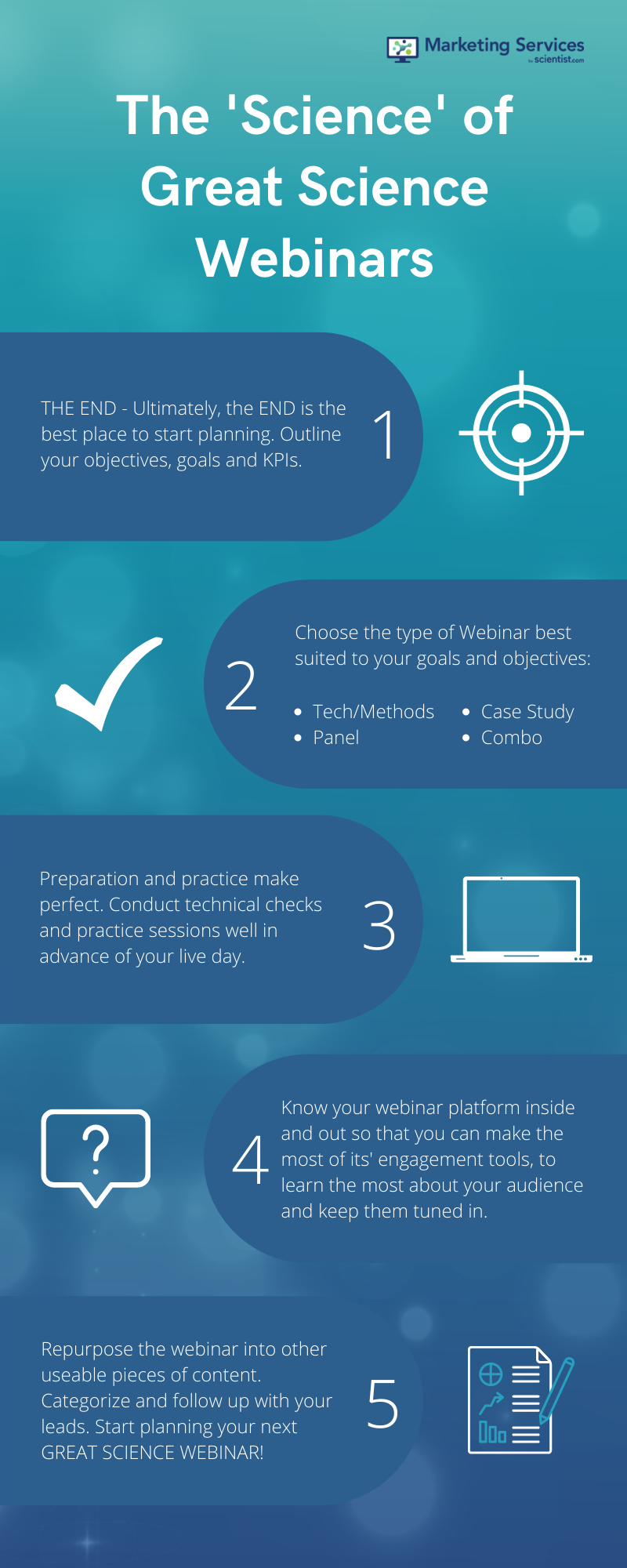While webinars have been around for quite some time, the concept of mass, borderless communication has taken the marketing scene by storm over the last two years. In its most simple form, a webinar is an online get-together, typically with one host and a speaker or two, with a one-way line of communication to an audience. But can they be more than that? What makes a webinar ‘great’ and where do you start?
Ultimately, the END is the best place to start planning.
The first step to planning a great webinar is to outline your objectives. By asking yourself (and maybe a few colleagues) a few questions you can relatively quickly pick out some main objectives and decide what it is that you want the webinar to do for you. For some, the list might look something like this:
- More leads. Full stop.
Now, this is a perfectly fine objective to have, but I would challenge you to think BEYOND the list of new names because, while you will receive a list full of untapped potential at the end of your webinar, there is so much more value left on the table. Considering that there are different types of webinars for different objectives, what else might you add to your list? Maybe with more thought it grows to something like this:
- More leads (Fill the top of the funnel)
- Build brand loyalty (Lead nurturing)
- Re-engage/educate current working leads and existing customers (Bottom of the funnel/Close deals)
- Create company marketing material
We’ll talk about the different types of webinars (ie. panel, case study, tech/methods, etc.) for different objectives in a later blog, but for now it is critical to tailor the structure and content of your webinar to your end goals. Once you have your goals outlined, you can choose the optimal webinar type to meet those objectives. The difference between a webinar and a great webinar is in the planning and preparation.
Practice makes perfect, but remember Murphy’s law.
Even the most experienced and knowledgeable speakers have a bad day every now and then. Even the most reliable webinar platform and internet provider can fail. Hiccups and hang ups are lurking around every corner, but if you prepare, practice, and give yourself enough time, you can mitigate or avoid most pitfalls. Great webinars do not come together quickly; give yourself enough time to check off every task without sacrificing practice and test sessions.
PRO TIP: Conduct technical checks and practice sessions well in advance of your live day. Ensure your speaker(s) are in the same location and using the same computer, microphone, and internet connection that they intend to use on the live webinar day.
Very simply put, technical checks involve checking a speaker’s ‘tech’: their internet connection, computer settings, and asking questions about their audio/video set up. For technical checks, we recommend to speakers that they have a hardwired internet connection when possible and have a headset or microphone that mitigates audio echoes and feedback. If everything is working optimally, that’s great news! But if it’s not, you’ll be glad that you checked before you’re in front of a live audience.
Whether this is your first webinar ever, or just the first this week, practice makes perfect, and you cannot practice too much. You know that your speaker is an expert in their field, but passionately communicating highly complex information can be a challenge for anyone. If a speaker stumbles through their presentation or reads directly from their slides/script, it is easy for the audience to lose interest. Similarly, if they blast through their content too quickly, you will be left with a dazed and confused audience with few questions for the Q&A session, because they were unable to fully appreciate the content. When a speaker feels comfortable and confident in their delivery, it can make for an outstanding webinar. So, don’t be afraid to encourage at least one practice session. Practice makes perfect, after all.
“This webinar could have been an article/e-book/cold call…”
When you think about the interactions that you have in a day, the ones that stand out are typically the ones that have you wondering what’s next and leave you wanting more. Webinars are no different; great webinars are engaging.
By now we have all sat through meetings that should have been emails, and webinars that could have been a written article or sales pitch. Captivating your audience, even if the subject is highly complex or technical, does not need to be difficult. You just have to know what is in your tool belt; even the most basic webinar platform has built-in engagement tools. How can you use polls, surveys, calls-to-action, and handouts to your advantage?
Going back to thinking about your typical interactions with people, when they only talk about themselves, or ask you questions that are self-serving, it’s hard to feel like they are genuinely interested in learning about you. Now imagine watching an hour long webinar where the presenter(s) are doing basically the same thing. How can you expect your audience to feel engaged if a webinar’s speaker is only talking about themself or their company? Think about what you would like to learn about your audience before the webinar even happens, so that you can strategically ask thoughtful and thought provoking questions before, during, and after the live event.
PRO TIP: Engagement in audience polls is highest when the polling questions are directly relevant to the presentation content. With that in mind, try to incorporate audience polls directly into the presentation material to learn more about attendees while making for a more fluid and interesting viewer experience.
Another great way to keep your audience engaged is to leave adequate time for a (or better yet, a few) Q&A session(s). Taking questions from registrants in advance of the live webinar can boost attendance and overall engagement since attendees will be waiting to hear their question answered. Highly technical and data driven presentations that don’t take advantage of natural content breaks can feel especially long and can have your viewers taking a few extra looks at their other browser tabs or leaving all together. Encourage speakers to take advantage of breaks in the content to learn more about them and answer audience questions while they are top of mind.
When someone registers for a webinar they expect polls, Q&A sessions and surveys to be part of the experience. ‘Wow’ the audience with a call-to-action that offers them a little something extra or exclusive. Examples of good calls-to-action include valuable downloads, promotional pricing only for webinar attendees, or a link to register for your next relevant webinar. Make it obvious, and guide your audience toward the next step you want them to take.
All of that to say, more is not always better. Ask too much, potential registrants might not hit submit on the registration page, attendees might stop answering, or worse, log off altogether and make a mental note not to register for your events in the future. Use engagement tools wisely and consider your end goals to come up with the appropriate balance of engagement and content. And keep in mind that each webinar is different! Engaging your audience during a panel webinar, for instance, will look different than during a case study or tech methods session.
When you plan with the end in mind, you never finish a webinar project and have to think “…now what?”
All of the speakers have been thanked, congratulations have been given, and the attendees have been sent on their way. You are left with a list of names, responses to some key questions, and a recording of a webinar. It is what you do with all of that data and content now that can set your webinar apart from the rest. Since you began this project with the end in mind, what comes next is the easy part.
You asked strategic questions of your registrants and attendees so that your sales team can more effectively place leads into different “buckets” for appropriate follow-up. A custom ‘Thank you!’ email to all attendees should look different than the follow-up you send to those who did not attend; and perhaps a few of the attendees asked for more specific information from your company, so their follow-up would look different as well. This is why it is very important to consider the questions you ask before and during the live event.
Within the hour after your webinar is complete, your marketing team can get to work repurposing the webinar into additional content because you planned your webinar content knowing that you wanted to use specific pieces for shorter videos, or audio clips. You do not have to be a professional podcaster or an expert writer to repurpose webinar content into a different medium.
There is little else to do, so, you could sit back and relax knowing that your webinar was great…but you are already planning your next great webinar!




